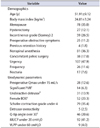1. Parden AM, Gleason JL, Jauk V, Garner R, Ballard A, Richter HE. Incontinence outcomes in women undergoing primary and repeat midurethral sling procedures. Obstet Gynecol. 2013; 121(2 Pt 1):273–278.
2. Schimpf MO, Rahn DD, Wheeler TL, Patel M, White AB, Orejuela FJ, et al. Sling surgery for stress urinary incontinence in women: a systematic review and metaanalysis. Am J Obstet Gynecol. 2014; 211:71.e1–71.e27.
3. Ford AA, Rogerson L, Cody JD, Ogah J. Mid-urethral sling operations for stress urinary incontinence in women. Cochrane Database Syst Rev. 2015; (7):CD006375.
4. Ulmsten U, Henriksson L, Johnson P, Varhos G. An ambulatory surgical procedure under local anesthesia for treatment of female urinary incontinence. Int Urogynecol J Pelvic Floor Dysfunct. 1996; 7:81–85.
5. Richter HE, Albo ME, Zyczynski HM, Kenton K, Norton PA, Sirls LT, et al. Retropubic versus transobturator midurethral slings for stress incontinence. N Engl J Med. 2010; 362:2066–2076.
6. Stanford EJ, Paraiso MF. A comprehensive review of suburethral sling procedure complications. J Minim Invasive Gynecol. 2008; 15:132–145.
7. Han JY, Lee KS, Choo MS. Management of recurrent or persistent stress urinary incontinence after mid-urethral sling. Low Urin Tract Symptoms. 2012; 4:Suppl 1. 95–101.
8. Giarenis I, Thiagamoorthy G, Zacchè M, Robinson D, Cardozo L. Management of recurrent stress urinary incontinence after failed midurethral sling: a survey of members of the International Urogynecological Association (IUGA). Int Urogynecol J. 2015; 26:1285–1291.
9. Lo TS, Jaili S, Tan YL, Wu PY. Five-year follow-up study of Monarc transobturator tape for surgical treatment of primary stress urinary incontinence. Int Urogynecol J. 2016; 27:1653–1659.
10. Ross S, Tang S, Eliasziw M, Lier D, Girard I, Brennand E, et al. Transobturator tape versus retropubic tension-free vaginal tape for stress urinary incontinence: 5-year safety and effectiveness outcomes following a randomised trial. Int Urogynecol J. 2016; 27:879–886.
11. Betari R, Meynier J, Forzini T, François T, Hakami F, Saint F. Is initial success after Monarc(®) suburethral sling durable at mid-term evaluation? Prog Urol. 2016; 26:409–414.
12. Serati M, Salvatore S, Siesto G, Cattoni E, Braga A, Sorice P, et al. Urinary symptoms and urodynamic findings in women with pelvic organ prolapse: is there a correlation? Results of an artificial neural network analysis. Eur Urol. 2011; 60:253–260.
13. Abrams P, Cardozo L, Fall M, Griffiths D, Rosier P, Ulmsten U, et al. The standardisation of terminology of lower urinary tract function: report from the Standardisation Sub-committee of the International Continence Society. Neurourol Urodyn. 2002; 21:167–178.
14. Mellier G, Benayed B, Bretones S, Pasquier JC. Suburethral tape via the obturator route: is the TOT a simplification of the TVT? Int Urogynecol J Pelvic Floor Dysfunct. 2004; 15:227–232.
15. Dmochowski RR, Blaivas JM, Gormley EA, Juma S, Karram MM, Lightner DJ, et al. Update of AUA guideline on the surgical management of female stress urinary incontinence. J Urol. 2010; 183:1906–1914.
16. Salin A, Conquy S, Elie C, Touboul C, Parra J, Zerbib M, et al. Identification of risk factors for voiding dysfunction following TVT placement. Eur Urol. 2007; 51:782–787.
17. Novara G, Galfano A, Boscolo-Berto R, Secco S, Cavalleri S, Ficarra V, et al. Complication rates of tension-free midurethral slings in the treatment of female stress urinary incontinence: a systematic review and meta-analysis of randomized controlled trials comparing tension-free midurethral tapes to other surgical procedures and different devices. Eur Urol. 2008; 53:288–308.
18. Delorme E. Transobturator urethral suspension: mini-invasive procedure in the treatment of stress urinary incontinence in women. Prog Urol. 2001; 11:1306–1313.
19. Giberti C, Gallo F, Cortese P, Schenone M. Transobturator tape for treatment of female stress urinary incontinence: objective and subjective results after a mean follow-up of two years. Urology. 2007; 69:703–707.
20. Taweel WA, Rabah DM. Transobturator tape for female stress incontinence: follow-up after 24 months. Can Urol Assoc J. 2010; 4:33–36.
21. Lee KS, Choo MS, Doo CK, Han DH, Lee YS, Kim JY, et al. The long term (5-years) objective TVT success rate does not depend on predictive factors at multivariate analysis: a multicentre retrospective study. Eur Urol. 2008; 53:176–182.
22. Reich A, Kohorst F, Kreienberg R, Flock F. Long-term results of the tension-free vaginal tape procedure in an unselected group: a 7-year follow-up study. Urology. 2011; 78:774–777.
23. Serati M, Ghezzi F, Cattoni E, Braga A, Siesto G, Torella M, et al. Tension-free vaginal tape for the treatment of urodynamic stress incontinence: efficacy and adverse effects at 10-year follow-up. Eur Urol. 2012; 61:939–946.
24. Heinonen P, Ala-Nissilä S, Räty R, Laurikainen E, Kiilholma P. Objective cure rates and patient satisfaction after the transobturator tape procedure during 6.5-year follow-up. J Minim Invasive Gynecol. 2013; 20:73–78.
25. Yonguc T, Gunlusoy B, Degirmenci T, Kozacioglu Z, Bozkurt IH, Arslan B, et al. Are the outcomes of transobturator tape procedure for female stress urinary incontinence durable in long-term follow-up? Int Urol Nephrol. 2014; 46:1295–1300.
26. Walsh CA, Moore KH. Recurrent stress urinary incontinence after synthetic midurethral sling procedure. Obstet Gynecol. 2010; 115:1296–1301.
27. Lorenzo-Gómez MF, Gómez-García A, Padilla-Fernández B, García-Criado FJ, Silva-Abuín JM, Mirón-Canelo JA, et al. Risk factors for failure after transobturator vaginal tape for urinary incontinence. Actas Urol Esp. 2011; 35:454–458.
28. Paick JS, Cho MC, Oh SJ, Kim SW, Ku JH. Factors influencing the outcome of mid urethral sling procedures for female urinary incontinence. J Urol. 2007; 178(3 Pt 1):985–989.
29. Paick JS, Oh SJ, Kim SW, Ku JH. Tension-free vaginal tape, suprapubic arc sling, and transobturator tape in the treatment of mixed urinary incontinence in women. Int Urogynecol J Pelvic Floor Dysfunct. 2008; 19:123–129.
30. Athanasiou S, Grigoriadis T, Zacharakis D, Skampardonis N, Lourantou D, Antsaklis A. Seven years of objective and subjective outcomes of transobturator (TVT-O) vaginal tape: why do tapes fail? Int Urogynecol J. 2014; 25:219–225.







 PDF
PDF ePub
ePub Citation
Citation Print
Print


 XML Download
XML Download